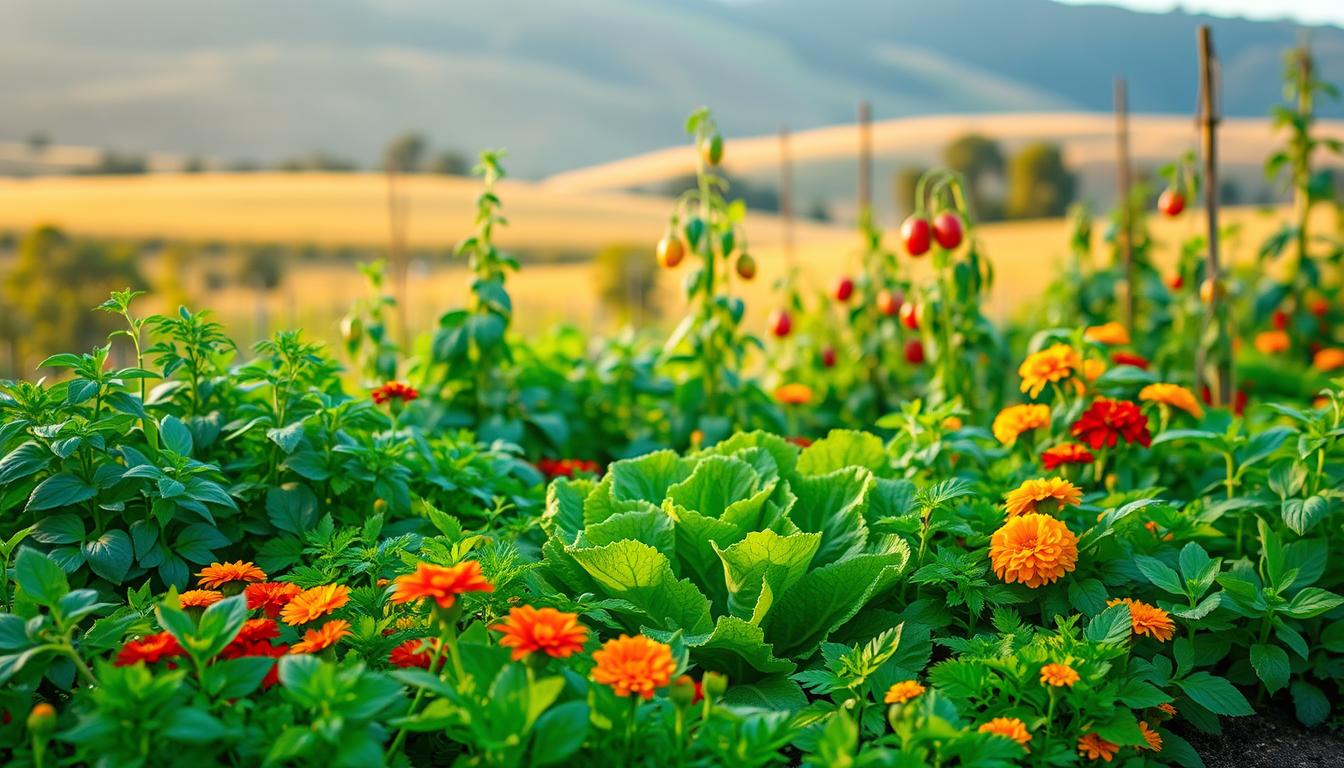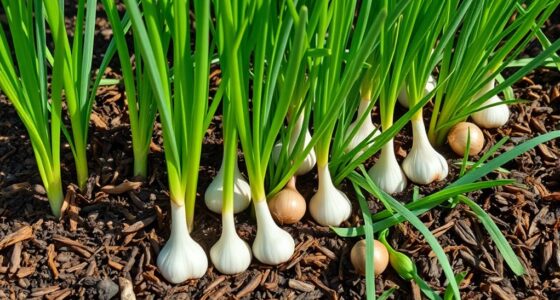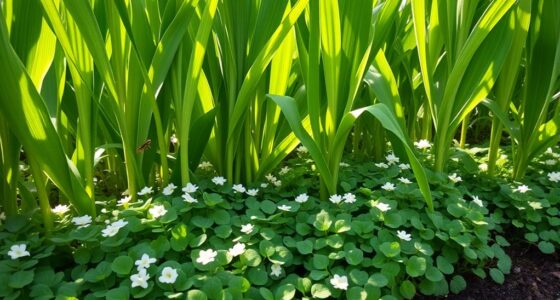Imagine stepping into your garden and witnessing a vibrant, thriving ecosystem, brimming with life and flavor. Companion planting can transform your ordinary plot into an extraordinary space, teeming with the benefits of nature’s best partnerships. When you cultivate lettuce alongside the right companions, you not only boost the growth potential but also enhance the flavors in your salad bowl. By strategically selecting lettuce companion plants, you can create a flourishing garden that supports your plants while deterring pests naturally. In this guide, you’ll discover the best plants to grow with lettuce, setting the stage for a rewarding growing experience that will leave your taste buds delighted and your garden flourishing.
Key Takeaways
- Companion planting lettuce can improve garden productivity and flavor.
- The right lettuce companion plants help deter pests naturally.
- Strategically selecting plants around lettuce supports healthier growth.
- A well-planned garden can create a mini-ecosystem that benefits all plants.
- Maximizing the benefits of companion planting can lead to exceptional yields.
Understanding Companion Planting
Companion planting is an agricultural strategy that involves growing different plants together for mutual benefits. This method is particularly effective when it comes to companion planting lettuce, where the right combinations can enhance growth and health. By carefully pairing compatible plants for lettuce, you can create a thriving environment that encourages healthy development while naturally managing pests.
What is Companion Planting?
Companion planting refers to the practice of strategically placing plants in proximity to each other for various advantages. These advantages include improved nutrient uptake, pest resistance, and overall plant vitality. For instance, certain flowers can attract beneficial insects, aiding in the pollination of vegetables like lettuce, while other plants may deter common pests.
Benefits of Companion Planting
Incorporating companion planting into your vegetable garden can bring numerous rewards. Some key benefits include:
- Pest Control: Certain plants repel harmful insects, protecting your lettuce from infestations.
- Enhanced Growth: Compatible plants can help each other flourish by sharing nutrients and resources.
- Soil Improvement: Some plants contribute organic matter to the soil, promoting fertility and health.
How to Choose Companion Plants
Selecting the right compatible plants for lettuce revolves around understanding their growth habits and needs. Here are a few tips:
- Consider the sunlight and water requirements of potential companions.
- Check for symbiotic relationships that enhance nutrient absorption.
- Evaluate how plants interact, looking for those that repel pests or attract beneficial insects.

With careful consideration, you can establish a diverse garden ecosystem by choosing the right vegetable garden companions for lettuce. This thoughtful approach will lead to healthier plants and a more fruitful harvest.
Top Companion Plants for Lettuce
When it comes to enhancing your lettuce garden, selecting the right companion plants can significantly impact growth and yield. Choosing the best plants to grow with lettuce not only fosters a more vibrant garden but also encourages healthy coexistence among crops. Below are some excellent options to consider for interplanting with lettuce.
Radishes
Radishes are a fantastic choice as they grow quickly, making them ideal for interplanting with lettuce. Their rapid development helps soften the soil and reduces competition for nutrients. This allows lettuce to thrive and mature more efficiently.
Carrots
Carrots, with their shallow root systems, make perfect neighbors for lettuce. They do not compete for the same resources, ensuring that both crops can flourish side by side. Including carrots in your lettuce companion crops promotes a harmonious relationship in the garden.
Onions
Onions belong to the allium family and offer pest-repelling qualities that are beneficial for lettuce. They deter harmful insects such as aphids and slugs, protecting your lettuce from damage. Including onions with your lettuce companions creates a balanced ecosystem that supports healthy growth.

Herbs That Thrive with Lettuce
Enhancing your garden with herbs that go well with lettuce can create a vibrant and productive space. These herbs not only complement the flavor of lettuce but also contribute to pest management and overall garden health. By incorporating these compatible plants for lettuce, you’ll establish a more balanced ecosystem in your garden.
Basil
Basil serves as a fantastic companion in your garden. Its strong aroma attracts beneficial insects that help control common pests. When you plant basil alongside lettuce, you not only enhance the flavor profile but also create a thriving environment that supports healthy growth.
Cilantro
Cilantro is another excellent choice in companion planting lettuce. Thriving in similar conditions, cilantro naturally deters pest species that can harm your lettuce crops. This alignment in growing requirements makes cilantro a compatible plant for lettuce, ensuring a harmonious garden layout.
Chives
Chives bring a unique advantage with their fragrant scent, which effectively repels undesirable pests like aphids. By including chives near your lettuce, you’ll create an additional layer of protection. The combination of these herbs and lettuce not only promotes growth but also helps in maintaining a pest-resistant garden.

Edible Flowers That Benefit Lettuce
Integrating edible flowers into your garden enhances both aesthetic appeal and functionality. Certain flowers offer multiple advantages when planted alongside lettuce. They not only attract beneficial insects but also serve as natural pest deterrents, promoting healthier lettuce crops.
Nasturtiums
Nasturtiums are a favorite among gardeners for their vibrant blooms and unique flavor. These edible flowers attract aphids, drawing them away from your beloved lettuce plants. By serving as a diversion, nasturtiums help maintain the health of your lettuce crop while adding a splash of color to your garden.
Marigolds
Marigolds stand out as a champion in pest control. Their strong scent effectively repels numerous garden pests, creating a protective barrier around your lettuce. Known as natural pest deterrents, marigolds not only nurture your plants but also contribute to a vibrant garden ecosystem, making them an excellent companion for lettuce.

Vegetables to Avoid Planting with Lettuce
In your quest for a thriving garden, understanding the plants to avoid with lettuce is essential for ensuring optimal growth. Certain vegetables can act as detrimental companions for lettuce, leading to competition for nutrients and hindered growth. By being aware of these candidates, you can make informed planting decisions.
Avoiding Nightshades
Nightshade family members, such as tomatoes and peppers, should be excluded from your lettuce garden. These plants consume a lot of nutrients from the soil, which can negatively impact lettuce development. Their root systems often compete intensely, stifling the germination and growth of your lettuce plants.
Steering Clear of Strong Roots
Another group to consider is strong-rooted vegetables like fennel. These plants release natural chemicals that inhibit the growth of nearby plants, including lettuce. This interaction can stunt your lettuce’s growth and overall health. Keeping these detrimental companions for lettuce out of your garden supports a healthier environment for your crops.
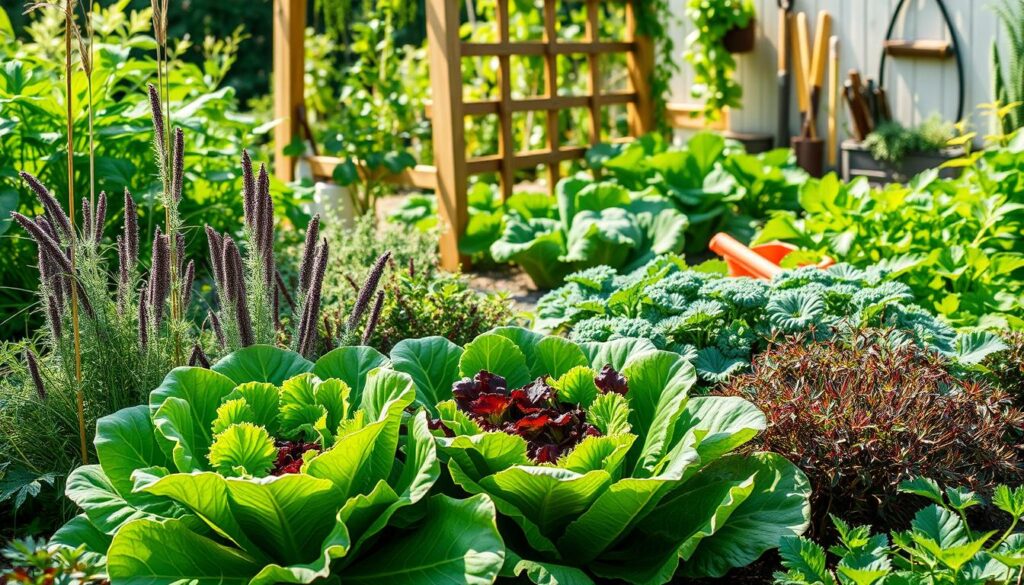
| Vegetable | Impact on Lettuce |
|---|---|
| Tomatoes | High nutrient competition, hinders germination |
| Peppers | Nutrient depletion, poor growth quality |
| Fennel | Growth-inhibiting chemicals, stunted growth |
By steering clear of these specific plants to avoid with lettuce, you create a more conducive atmosphere for your lettuce to flourish. Focus on nurturing compatible companions while keeping these less favorable options at bay for a successful garden.
Timing Your Planting
Understanding the right timing for planting lettuce and its companion plants is crucial for achieving a bountiful harvest. Knowing when to plant can significantly make a difference in how your garden grows. With the right approach, you can utilize the cooler seasons to your advantage, ensuring all plants thrive during their peak periods.
When to Plant Lettuce and Companions
Lettuce is typically best planted in the spring and fall, as these cooler temperatures promote healthy growth. Ideal timing for lettuce planting often coincides with the last frost date in your area. Companion plants should be selected based on their compatible growth patterns and seasonal needs. By following a well-structured companion planting guide, you can ensure these plants flourish alongside your lettuce.
Seasons That Favor Companion Pairings
Certain seasons favor specific companion pairings. For example, cool-season vegetables pair well with lettuce during spring and fall. It is wise to avoid planting heat-sensitive companions in the summer, as they might struggle in the heat alongside lettuce. By understanding seasonal trends and growing conditions, you enhance your chances of success in your garden.

Space Requirements for Companion Plants
Understanding the space requirements for lettuce companions can significantly influence your gardening success. Lettuce has a unique ability to thrive alongside a variety of crops, primarily due to its shallow root system. This characteristic allows you to utilize the available garden space efficiently while maintaining a healthy environment for all plants involved.
Understanding Spatial Needs
When planning your garden layout, consider the growth patterns and root depths of your chosen companion plants. Lettuce leaves minimal impact on neighboring crops, which makes it ideal for interplanting. Ensure that you provide adequate space between plants, allowing for optimal airflow and reducing competition for nutrients. For example, pairing lettuce with radishes or onions can enhance both the aesthetic appeal and the productivity of your garden.
How to Maximize Your Garden Space
One effective technique for maximizing garden space involves interplanting. Group companion plants together in a way that their growth complements one another. This strategy fosters a more productive garden while minimizing resource competition. Here are some tips to get started:
- Plant lettuce in rows alongside quicker-growing companions, such as radishes.
- Utilize vertical gardening methods for taller plants like tomatoes to free up space below.
- Incorporate a staggered planting schedule, allowing you to harvest crops at different times, thus optimizing the space you have available.
By understanding the space requirements for lettuce companions and applying these techniques, you will create an efficient and flourishing garden. This mindful approach to maximizing garden space not only benefits your crops but also contributes to a healthier ecosystem.

| Companion Plant | Recommended Spacing (inches) | Growth Habit |
|---|---|---|
| Radishes | 4-6 | Fast-growing |
| Onions | 6-8 | Tall, upright |
| Carrots | 3-4 | Underground |
| Basil | 12-18 | Bushy |
Soil and Nutrient Considerations
Growing healthy lettuce involves understanding its soil requirements as well as the nutrient dynamics of companion plants. Lettuce thrives in a rich, well-draining soil that holds moisture without becoming waterlogged. Proper soil conditions promote better root development, ensuring your lettuce achieves optimal growth.
Best Soil Types for Lettuce
The ideal soil for lettuce is loamy and rich in organic matter. It should have a pH level between 6.0 and 7.0. This range fosters nutrient uptake and overall health of the plants. Look for soil mixes that retain moisture while allowing air to circulate around the roots. Here are some key soil types to consider:
| Soil Type | Characteristics | Benefits for Lettuce |
|---|---|---|
| Loamy Soil | Balanced mixture of sand, silt, and clay. | Offers good drainage and retains nutrients. |
| Alluvial Soil | Rich in minerals due to sediment deposits. | Provides essential nutrients, promoting healthier growth. |
| Organic Compost | Decomposed plant material with beneficial microorganisms. | Enhances soil fertility and water retention. |
Nutrient-Rich Companions
Cultivating companion plants that address the nutrient considerations for companion plants can substantially benefit your lettuce crop. For instance, legumes are known for their ability to fix nitrogen in the soil, enhancing fertility for surrounding plants. Other companions like calendula or marigolds attract pollinators while also repelling pests, creating a flourishing ecosystem in your garden.
- Legumes (e.g., peas, beans) – Enhance nitrogen levels in the soil.
- Herbs (e.g., basil, mint) – Provide nutrients and deter pests.
- Brassicas (e.g., kale, broccoli) – Help loosen the soil and improve drainage.
The right combination of soil and nutrient-rich companion plants will elevate your lettuce production, supporting a vibrant, productive garden.
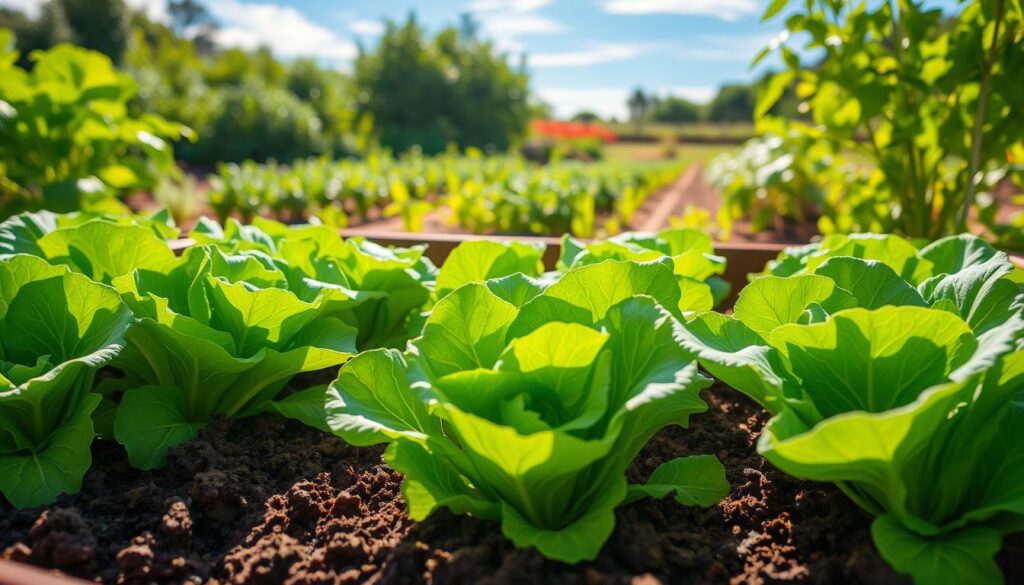
Pest Control through Companion Planting
Companion planting can serve as an effective strategy for pest control, utilizing natural methods that encourage beneficial relationships among plants. This method not only helps in protecting your lettuce but also promotes a balanced ecosystem in your garden. By selecting the right companions, you can enhance natural pest control and minimize damage from unwanted visitors.
Natural Pest Deterrents
Certain plants possess properties that repel pests harmful to your lettuce, thereby assisting in natural pest control. For instance, alliums, such as garlic and onions, emit strong odors that dissuade many common garden pests. Their presence in your garden can be an excellent strategy for those pursuing companion planting for pest management.
Plants That Attract Beneficial Insects
In addition to deterrents, you can introduce plants that attract beneficial insects, which further supports your pest management efforts. Flowers like calendula play a crucial role in luring in ladybugs and predatory wasps, both of which feast on destructive pests. Incorporating these plants into your garden not only benefits your lettuce but also supports an ecosystem where beneficial organisms can thrive.

Watering Tips for Companion Gardens
Effective watering practices are essential for maintaining a healthy companion garden, particularly when growing lettuce. Understanding the specific watering guidelines for lettuce can significantly enhance the growth of your plants. Consistent moisture is critical, especially during warmer months when water evaporation occurs more quickly.
Irrigation Techniques
Utilizing efficient irrigation techniques can make a difference in the health of your garden. Drip irrigation systems offer a targeted approach, delivering water directly to the roots without wetting the foliage. This method reduces the risk of disease and prevents water wastage. Frequent, light watering is another effective strategy, ensuring that the soil remains moist without becoming waterlogged.
Watering Needs of Lettuce and Companions
Knowing the watering needs of lettuce and its companion plants is crucial for a vibrant garden. Lettuce thrives in consistently moist soil, while many companion plants, like herbs and certain flowers, equally benefit from regular watering. Monitoring your garden’s moisture levels, particularly in dry spells, will help you adjust your approach based on the plants’ requirements. Following these irrigation tips for gardens will foster a flourishing growth environment.

Harvesting Together: When and How
Knowing the right time to harvest is essential for maintaining the freshness and flavor of both lettuce and its companions. Understanding the maturity signs for lettuce will help you determine when to pick your crops for the best taste and nutrition. In addition, being aware of the harvest timelines for companion plants ensures you can enjoy the bounty of your garden all at once.
Signs of Maturity in Lettuce
To identify when your lettuce is ready for harvesting, look for specific signs that indicate maturity. Key factors include:
- Leaf size: Ideally, leaves should reach 6 to 10 inches in length, depending on the variety.
- Texture: Leaves should feel crisp and firm, indicating they are at their peak.
- Color: A vibrant green shade signifies healthy growth.
Harvesting Your Companion Crops
When it comes to harvesting companion crops, timing varies based on the plant. For instance:
| Companion Plant | Harvest Time | Maturity Signs |
|---|---|---|
| Radishes | 4-6 weeks after planting | Firms up and develops good color |
| Carrots | 10-12 weeks after planting | Top of the carrot just peeks through the soil |
| Onions | 90-120 days after planting | Leaves start to yellow and fall over |

Incorporating these tips for harvesting lettuce and companions will ensure you enjoy ripe, flavorful produce from your garden. By recognizing maturity signs for lettuce and planning your harvest, you will maximize the quality and yield of your crops.
Rotating Your Crops
Crop rotation is a fundamental practice for anyone looking to maintain a healthy garden. It involves changing the types of crops grown in a particular area from season to season. Applying effective crop rotation tips not only enhances soil health but also minimizes pest problems. Benefits of rotating crops include preventing nutrient depletion and disrupting pest cycles, contributing to a more sustainable gardening approach.
Importance of Crop Rotation
Implementing crop rotation is crucial for maintaining soil fertility and promoting a biodiverse ecosystem. Different plants have varying nutrient needs, and rotating them helps restore soil nutrients naturally. This technique significantly reduces the risk of soil-borne diseases and pests establishing in your garden, which ultimately leads to higher yields and healthier plants.
Effective Rotation Strategies
When planning your crop rotation, consider the following strategies:
- Group plants by family: Rotate crops within the same plant family, such as legumes and leafy greens, to improve soil biodiversity.
- Mix root and leafy crops: Alternate between root vegetables and leafy greens to help balance nutrient levels. For example, planting carrots one season followed by lettuce the next can enhance soil structure.
- Incorporate cover crops: Plant cover crops in the off-season to protect and enrich the soil. Clover and rye can add nutrients and prevent erosion.
| Crop Type | Best Follow-Up Crop | Benefits |
|---|---|---|
| Leafy Greens | Root Vegetables | Helps replenish nitrogen and improve soil texture. |
| Legumes | Leafy Greens | Enhances nitrogen levels for subsequent crops. |
| Root Vegetables | Fruiting Plants | Reduces soil compaction and supports diverse nutrient profiles. |

Tips for a Successful Companion Planting
Engaging in successful companion planting requires knowledge, patience, and skills. By following some guidelines, you can cultivate a flourishing garden filled with vibrant plants. It’s essential to understand the compatibilities between plants, maintain soil health, and manage your garden’s space effectively. Be aware of common pitfalls in planting that could hinder your gardening success.
General Guidelines
- Research plant compatibilities: Knowing which plants grow well together plays a significant role in fostering healthy growth.
- Maintain soil health: Ensure that your soil has the right nutrients and structure for both lettuce and its companions.
- Avoid overcrowding: Providing ample space for each plant allows for air circulation and sunlight exposure.
- Consider sunlight requirements: Align the sunlight needs of your plants to optimize growth and yield.
- Water needs: Tailor your watering strategy to accommodate the specific hydration requirements of different plants.
Common Mistakes to Avoid
- Neglecting plant growth stages: Be aware of how different life cycles can affect companion relationships.
- Ignoring disease propagation: Some plants can attract pests or diseases that may adversely affect their companions.
- Overlooking nutrient competition: Ensure that plants don’t compete for the same nutrients, which can stunt growth.
- Failing to document outcomes: Keep records of your gardening successes and failures; this will enhance your future efforts.

By adhering to these guidelines and steering clear of common pitfalls in planting, your journey into companion planting can lead to a robust and productive garden.
Building a Pollinator-Friendly Garden
Cultivating a pollinator-friendly garden contributes significantly to local ecosystems. By choosing the right plants, you can create a haven for bees and other vital pollinators. These creatures not only enrich your garden’s beauty but also enhance productivity, making your efforts more fruitful.
Plants That Attract Bees
Selecting specific pollinator plants will greatly benefit your garden. Consider incorporating flowers such as:
- Lavender – Its aromatic blooms attract bees and provide a lovely fragrance.
- Echinacea – This vibrant flower draws in butterflies and is known for its resilience.
- Sunflowers – Tall and bright, they are a perfect attraction for various insects.
- Bee Balm – Known for its bright colors and scent, it entices bees and hummingbirds alike.
Enhancing Biodiversity
To support biodiversity in gardens, mix a variety of species. A diverse ecosystem promotes healthy plant growth and resilience against pests. Here are some additional tips to enrich your garden’s biodiversity:
| Plant Type | Biodiversity Benefit |
|---|---|
| Herbs (e.g., thyme, mint) | Provide essential nectar and habitat for pollinators. |
| Native Flowers (e.g., black-eyed Susan, milkweed) | Support local wildlife and attract native pollinators. |
| Ground Covers (e.g., clover) | Prevent soil erosion and improve nutrient cycling. |

Integrating these elements fosters a strong ecosystem that not only supports pollinators but also enhances the overall health of your garden. A focus on biodiversity in gardens ensures sustainable growth, leading to a more vibrant and productive environment for your plants, including your beloved lettuce companions.
Resources for Further Learning
Expanding your knowledge about companion planting can greatly enhance your gardening experience. Whether you prefer reading or engaging with a community, numerous resources are available for you. Consider exploring various gardening books and online resources for gardeners that provide valuable insights into the art of companion planting.
Books on Companion Planting
Many gardening books are dedicated to companion planting, offering in-depth guidance. Notable titles include Carrots Love Tomatoes by Louise Riotte, which outlines the benefits of pairing specific plants for improved growth and pest management. Another excellent resource is The Garden Primer by Barbara Damrosch, which gives a comprehensive overview of gardening techniques, including companion planting strategies.
Online Gardening Communities
Joining online gardening communities helps you connect with fellow gardeners who share your interests. Platforms like Reddit’s r/gardening create spaces for discussing companion planting and exchanging tips. Additionally, various Facebook groups cater to different gardening styles, making it easy to find support and advice related to companion planting.

| Resource Type | Name | Description |
|---|---|---|
| Book | Carrots Love Tomatoes | Guidance on beneficial plant pairings and pest management. |
| Book | The Garden Primer | Comprehensive overview of gardening practices including companion planting. |
| Online Community | Reddit r/gardening | Discussion platform for sharing gardening experiences and tips. |
| Online Community | Facebook Gardening Groups | Supportive communities sharing advice focused on specific gardening styles. |
Your Companion Planting Journey
As you reflect on your companion planting journey, consider the successes and challenges you experienced throughout the growing season. An effective results review for gardeners is essential not only to appreciate what worked well but also to identify areas for improvement. Documenting your observations can provide valuable insights that enhance your future planting efforts.
Think about which combinations thrived and how your lettuce and companion plants interacted. Each season offers a fresh opportunity for experimentation. This is key to mastering the art of companion planting, allowing your garden to evolve and flourish. Adjusting your strategies based on what you’ve learned will ensure optimal growth for both your lettuce and its companions.
Take this time to hone your skills as a gardener. Embrace the learning curve that comes with each planting cycle, and use your results to create a dynamic garden. With every new season, you have the chance to refine your approach, leading to a more productive and vibrant companion planting journey.
